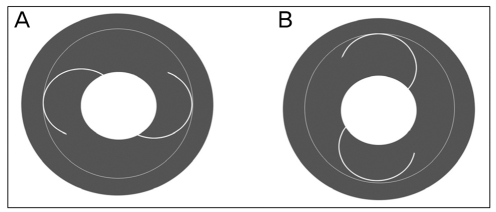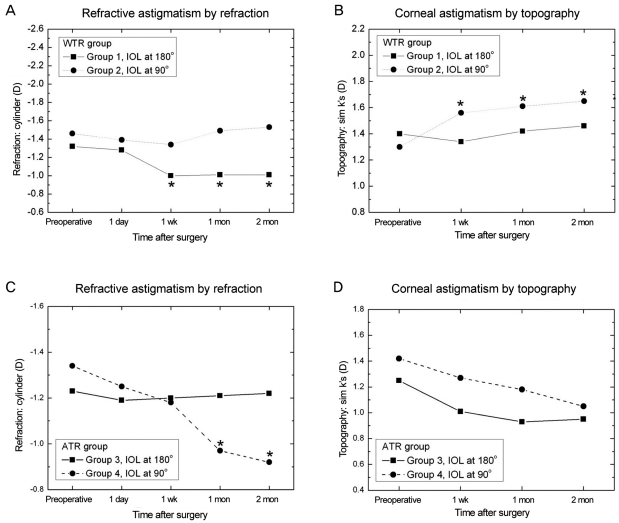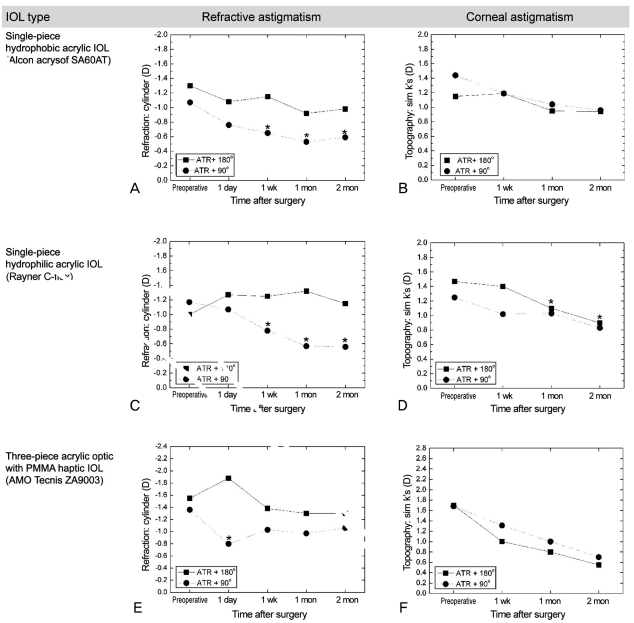Korean J Ophthalmol.
2011 Feb;25(1):22-28. 10.3341/kjo.2011.25.1.22.
Postoperative Astigmatic Outcomes Based on the Haptic Axis of Intraocular Lenses Inserted in Cataract Surgery
- Affiliations
-
- 1Department of Ophthalmology and Visual Science, Yeouido St. Mary's Hospital, The Catholic University of Korea School of Medicine, Seoul, Korea. sara514@catholic.ac.kr
- 2Department of Ophthalmology and Visual Science, Seoul St. Mary's Hospital, The Catholic University of Korea School of Medicine, Seoul, Korea.
- KMID: 994407
- DOI: http://doi.org/10.3341/kjo.2011.25.1.22
Abstract
- PURPOSE
This study was conducted to compare post-operative astigmatic outcomes of two groups, with-the-rule (WTR) and against-the-rule (ATR) astigmatism patients, according to the haptic axis of intraocular lenses (IOLs) inserted in cataract surgery.
METHODS
Seventy-two eyes with WTR astigmatism and 79 eyes with ATR astigmatism had cataract surgery through a clear corneal temporal incision. These two groups of eyes were then each divided into 2 groups based on whether the haptic axis of the inserted IOL was at 180degrees or 90degrees. For ATR patients, the outcomes were analyzed according to the three types of IOLs.
RESULTS
There was no difference in corneal astigmatism, but WTR patients with a 180degrees haptic axis of the inserted IOL and ATR patients with a 90degrees hepatic axis of the inserted IOL had a significant decrease in postoperative refractive astigmatism (p < 0.05). The changes in ATR astigmatism according to the IOL type were more effective in single-piece acrylic IOLs than in the three-piece polymethylmethacrylate haptic IOL group.
CONCLUSIONS
Insertion of the IOL at the 180degrees haptic axis in WTR patients and at 90degrees in ATR patients during cataract surgery may have an effect in reducing pre-existing astigmatism. This observed effect was not consistent among the different types of IOLs.
Keyword
MeSH Terms
Figure
Reference
-
1. Hoffer KJ. Biometry of 7,500 cataractous eyes. Am J Ophthalmol. 1980; 90:360–368. PMID: 7425052.
Article2. Tejedor J, Murube J. Choosing the location of corneal incision based on preexisting astigmatism in phacoemulsification. Am J Ophthalmol. 2005; 139:767–776. PMID: 15860279.
Article3. Khokhar S, Lohiya P, Murugiesan V, Panda A. Corneal astigmatism correction with opposite clear corneal incisions or single clear corneal incision: comparative analysis. J Cataract Refract Surg. 2006; 32:1432–1437. PMID: 16931252.
Article4. Bayramlar HH, Dağlioğlu MC, Borazan M. Limbal relaxing incisions for primary mixed astigmatism and mixed astigmatism after cataract surgery. J Cataract Refract Surg. 2003; 29:723–728. PMID: 12686239.
Article5. Barequet IS, Yu E, Vitale S, et al. Astigmatism outcomes of horizontal temporal versus nasal clear corneal incision cataract surgery. J Cataract Refract Surg. 2004; 30:418–423. PMID: 15030834.
Article6. Kaufmann C, Peter J, Ooi K, et al. Limbal relaxing incisions versus on-axis incisions to reduce corneal astigmatism at the time of cataract surgery. J Cataract Refract Surg. 2005; 31:2261–2265. PMID: 16473215.
Article7. Cravy TV. Routine use of a lateral approach to cataract extraction to achieve rapid and sustained stabilization of postoperative astigmatism. J Cataract Refract Surg. 1991; 17:415–423. PMID: 1895218.
Article8. Lyle WM. Changes in corneal astigmatism with age. Am J Optom Arch Am Acad Optom. 1971; 48:467–478. PMID: 5281065.
Article9. Dunne MC, Elawad ME, Barnes DA. A study of the axis of orientation of residual astigmatism. Acta Ophthalmol (Copenh). 1994; 72:483–489. PMID: 7825418.
Article10. Bennett AG. Analysis of three meridional keratometric measurements of the anterior cornea. Ophthalmic Physiol Opt. 1990; 10:93–94. PMID: 2330223.
Article11. Werner L, Olson RJ, Mamalis N. New technology IOL optics. Ophthalmol Clin North Am. 2006; 19:469–483. PMID: 17067902.12. Mendicute J, Irigoyen C, Aramberri J, et al. Foldable toric intraocular lens for astigmatism correction in cataract patients. J Cataract Refract Surg. 2008; 34:601–607. PMID: 18361982.
Article13. Marcos S, Barbero S, Jiménez-Alfaro I. Optical quality and depth-of-field of eyes implanted with spherical and aspheric intraocular lenses. J Refract Surg. 2005; 21:223–235. PMID: 15977879.
Article14. Holladay JT, Van Dijk H, Lang A, et al. Optical performance of multifocal intraocular lenses. J Cataract Refract Surg. 1990; 16:413–422. PMID: 2380922.
Article15. Solomon KD, Apple DJ, Mamalis N, et al. Complications of intraocular lenses with special reference to an analysis of 2,500 explanted intraocular lenses (IOLs). Eur J Implant Refract Surg. 1991; 3:195–200.
Article16. Ravalico G, Parentin F, Baccara F. Effect of astigmatism on multifocal intraocular lenses. J Cataract Refract Surg. 1999; 25:804–807. PMID: 10374161.
Article17. Walkow L, Klemen UM. Patient satisfaction after implantation of diffractive designed multifocal intraocular lenses in dependence on objective parameters. Graefes Arch Clin Exp Ophthalmol. 2001; 239:683–687. PMID: 11688668.
Article18. Naeser K, Behrens JK, Naeser EV. Quantitative assessment of corneal astigmatic surgery: expanding the polar values concept. J Cataract Refract Surg. 1994; 20:162–168. PMID: 8201567.
Article19. Grosvenor T, Ratnakaram R. Is the relation between keratometric astigmatism and refractive astigmatism linear? Optom Vis Sci. 1990; 67:606–609. PMID: 2216327.
Article20. Elliott M, Callender MG, Elliott DB. Accuracy of Javal's rule in the determination of spectacle astigmatism. Optom Vis Sci. 1994; 71:23–26. PMID: 8145993.
Article21. Bae JG, Kim SJ, Choi YI. Pseudophakic residual astigmatism. Korean J Ophthalmol. 2004; 18:116–120. PMID: 15635824.
Article22. Park HY, Kim HS. The changes of with-the-rule astigmatism after clear corneal temporal incision cataract surgery. J Korean Ophthalmol Soc. 2008; 49:433–441.
Article
- Full Text Links
- Actions
-
Cited
- CITED
-
- Close
- Share
- Similar articles
-
- Transscleral Fixation of Posterior Chamber Intraocular Lens in Aphakia
- The Changes of With-the-rule Astigmatism After Clear Corneal Temporal Incision Cataract Surgery
- Comparison of Anterior Capsule Stability Following Implantation of Three Single Piece Acrylic Intraocular Lenses with Different Haptic Design
- Effect of Haptic Material and Number of Intraocular Lens on Anterior Capsule Contraction after Cataract Surgery
- The Comparison of Postoperative Astigmatic Changes Between Phscoemulsification and Planned Extracapsular Cataract Extraction




